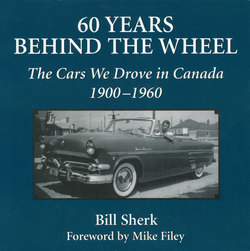Читать книгу 60 Years Behind the Wheel - Bill Sherk - Страница 11
На сайте Литреса книга снята с продажи.
Оглавление“Look, Ma! No Steering Wheel!”
THIS CAR IS SO OLD it doesn’t even have a steering wheel. Steering is by tiller. Its a Curved Dash Oldsmobile, a popular model in production from 1901 through 1906, and powered by a horizontally mounted one-cylinder engine. Over twenty thousand of these sporty little runabouts were sold. The first one into Canada was reportedly purchased by a minister in Oil Springs, Ontario. The one seen here is participating in a parade of jalopies along Lakeshore Boulevard in Toronto in 1930.
In October 1901, Roy Chapin left the Detroit factory in a Curved Dash Olds, crossed the Detroit River into Windsor, Canada, on a car ferry, and drove across southern Ontario, heading for the second annual auto show in Madison Square Garden in New York. The trip took over seven days, but he made it. When he arrived at the Waldorf-Astoria Hotel, he was so dusty and dirty from driving hundreds of miles on primitive roads that the doorman refused to let him in. He entered through the back door. The publicity generated by this trip was the best advertisement a car company could have, and these little Oldsmobiles began selling as fast as the factory could crank them out. Chapin’s route to New York took him across southern Ontario because that was the shortest route. The Canadians who saw him whizzing by at his top speed of 25 miles per hour, or mired in the mud, were probably getting their very first look at this new invention.
Back then, and even today at antique car events, these little Oldsmobiles were easily recognized by their dashboard, which was curved for better visibility. And how did the word “dashboard” come to be applied to the part of a car in front of the driver? The answer can be found in 500 Years of New Words:
That part of an automobile we still call the dashboard can be traced back to the days of horses and buggies. The Oxford English Dictionary (OED) defines dashboard as “a board or leather apron in the front of a vehicle, to prevent mud from being splashed by the heels of the horses upon the interior of the vehicle.” The first writer who used the word (according to the OED) was John Lang in “Wanderings in India,” published in 1859: “He fell asleep, his feet over the dashboard, and his head resting on my shoulder.”1
Webster’s Ninth New Collegiate Dictionary dates the word even farther back — to 1846.
Modern-day auto buffs who pride themselves on precision in language prefer to call the dashboard the instrument panel because its no longer there to protect you from chunks of mud flying from horses’ hooves.
